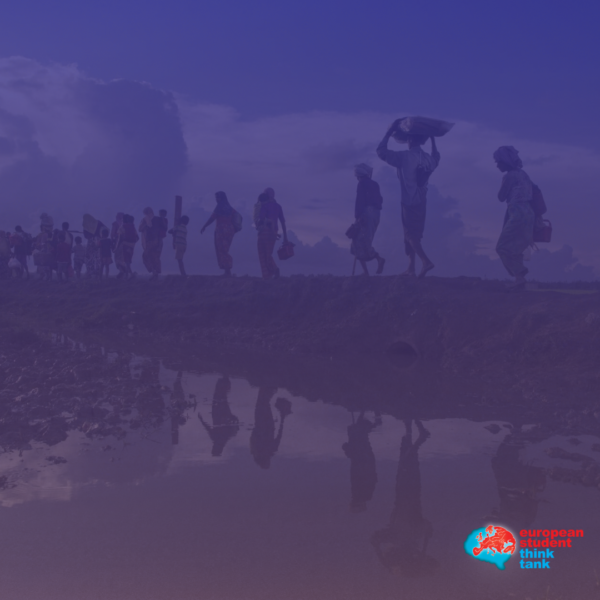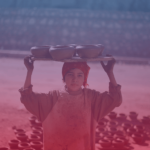
Written by: Bernat Baena, Ambassador to Belgium
Edited by: Iorgus-Serghei Cicala
1. Introduction
The Rohingya crisis stands as one of the most devastating instances of ethnic cleansing and genocide in recent history. Originating from Myanmar’s long-standing ethnic divisions, the persecution of the Rohingya minority escalated dramatically in 2017, with brutal military crackdowns that killed thousands and displaced hundreds of thousands, forcing them into neighbouring Bangladesh. This violence was widely condemned as a “textbook example of ethnic cleansing” by the United Nations.
The European Union has responded to the crisis with humanitarian aid, diplomatic pressure, and sanctions, including an arms embargo and restrictions for perpetrators of human rights violations. However, despite these efforts, the EU’s actions have been criticized as insufficient to stop the genocide. The international community’s broader response, including actions by the United Nations and the International Criminal Court, has faced significant challenges due to Myanmar’s rejection of international oversight and the limitations of existing legal mechanisms. By the same token, regional organizations like ASEAN have proven ineffective despite the agreements reached.
Central to the debate surrounding the crisis is the Responsibility to Protect (R2P) doctrine, which calls for international intervention when a state fails to protect its populations from genocide, war crimes, or crimes against humanity. As the situation persists, the Rohingya continue to face widespread persecution. In this regard, the global community’s failure to enforce meaningful accountability and interventions resurfaces as a key issue, with economic partnerships remaining stagnant. This ultimately exposes the very incongruence between the West’s pleas and actions.
2. Historical and Sociopolitical Roots of the Crisis
Myanmar has been recognized as an ethnic state that has been suffering constant ethnic conflict since its 1948 independence from the British. The disruption of the pre-colonial order, which priorly allowed for social mobility and ethnic integration, was replaced by the rigid imperial administration that segregated the Burmese into Burma proper and other ethnic minorities along the Frontier Areas. The externally imposed divides have created deep social fragmentation that would fuel the future ethnic hostilities. These divisions created inside Burma paved the way for the emergence of several ethnic identities within the state and led to grievances that were later turned by the Burmese majority into anger and violence against minority groups (Lieberman, 1978).
The Rohingya, originally from the Arakan coastal region of Myanmar, fled for the first time in 1799 to British Bengal, escaping persecution by the Bamar. They were a small Muslim minority that lived together with the Rakhine Buddhist population (History of the Rohingya – Rohingya Culture Center, n.d.). However, during colonial rule, the British encouraged them and other Indians and Bengalis to migrate and settle to work in the paddy fields and tea plantations, allowing them to return to their region. Moreover, minorities were preferred to hold administrative positions, while the Burmese were being marginalized. This created a perception among the Burmese majority that the Muslim minorities were a threat. When the Japanese invaded Burma in 1942 – 45, the British retreated to India, paving the way for intercommunal violence between Buddhist Rakhine and the Muslim Rohingya (History of the Rohingya – Rohingya Culture Center, n.d.).
After Myanmar’s independence and the subsequent creation of a parliamentary system, the Burmese representing 68% of the population rose to power. Replicating their suffering under British rule, the Burmese elite applied the same policies to the ethnic minorities regarded as “enemies of the nation” (Robinne F., 2020). After the 1962 coup, Myanmar’s political power started the “Burmanisation” policies, ranging from the imposition of a unitary image and the prohibition of minority languages to various cultural and confessional restrictions in a bid to erase minority identities and affirm majoritarian values. The first migration the Rohingya had to go through was in 1971 when, after the Bangladeshi Liberation War, some Bengalis were forced to migrate to Arakan, which triggered local protests from the Buddhist population. This resulted in the Burmese government expelling over 200.000 Muslims from the region, including the native Rohingya (History of the Rohingya – Rohingya Culture Center, n.d.).
Despite past discrimination, it was not until 1982 with the Citizenship Law that Rohingya suffered an institutionalized exclusion by the state of Myanmar, which barred them from the “national races” entitled to citizenship. This measure was used to marginalize the Rohingya and legitimize all types of violence towards them (Rusconi, 2023). Citizenship gives people a well-defined identity inside a political community, allowing them to enjoy state-granted and law-protected benefits and rights (Rusconi, 2023). These civil rights were taken away from the Rohingya minority back in 1982, rendering them vulnerable to ethnic cleansing.
3. 2012 Violent Escalation and First International Responses
The violence in 2012 marked a turning point in the crisis when communal violence erupted in Myanmar’s Rakhine State, primarily between the majority Buddhist Rakhine and the minority Rohingya populations. This unrest was triggered by allegations of rape and murder of a Buddhist woman by Rohingya men, followed by retaliatory attacks, leading to widespread destruction and displacement (Human Rights Watch, 2013). According to UNHCR, 80.000 people were displaced, and the UN High Commissioner for Human Rights, Nvail Pillay, stated: “We have been receiving a stream of reports from independent sources alleging discriminatory and arbitrary responses by security forces, and even their instigation of and involvement in clashes,” (UN, 2012). As the days passed, more declarations motivated the urgency of the situation. Phil Robertson, deputy Asia director, stated that “the Burmese government engaged in a campaign of ethnic cleansing against the Rohingya that continues today through the denial of aid and restrictions on movement” (Human Rights Watch 2013).
In a resolution on September 2012, the European Parliament stressed the need for Burmese authorities to “stop arbitrary arrests of Rohingya, allow the UN agencies and humanitarian NGOs and diplomats access to the Rakhine state and bring the perpetrators of the violent clashes to justice, not only those from the Rohingya minority” (European Parliament, 2012). They also insisted that the Rohingya minority could not be left out of the new Myanmar/Burma, and called on the government to “amend the 1982 citizenship law to bring it into line with international human rights standards and its obligations under Art.7 of the UN Convention of the Rights of the child, with a view to grating citizens’ rights to the Rohingya, as well as ensuring equal treatment for all Burmese citizens” (European Parliament, 2012). Beyond the said declaration, there was no significant aid or intervention by the EU specifically targeting the Rohingya ethnic cleansing in Myanmar. The international response during this period was primarily focused on advocacy, diplomatic engagement, and limited aid delivery, without substantial on-ground intervention. Yet the first steps were being taken by the international community.
4. The 2017 Crackdown
Despite international efforts to ease tensions, the military and the Burmese majority persisted with the discrimination and the marginalization of the Rohingya. Thus, the perceived grievances inside the Muslim community led to the creation of rebel groups. Further building on their long-endured suffering, it was the Arakan Rohingya Salvation Army that, by attacking a group of police and border guards and killing 12 officers, triggered a response from the Burmese military. The latter was described by the UN human rights body as a “devastating cruelty” (Meixler, 2018). In response to these attacks, the Tatmadaw (military) launched a counterinsurgency campaign, leading to the killing of 6700 Rohingya and to the displacement of around 770.000 crossing the border into Bangladesh (Médecins Sans Frontières. n.d).
As the events went on, the first international reactions were harsh against the Myanmar government, with accusations like the one from the UN Special Rapporteur for Human Rights Yanghee Lee, who defined the campaign as “the hallmarks of genocide.” Likewise, the High Commissioner defined it as “textbook example of ethnic cleansing” (Meixler, 2018). The EU responded with yet another resolution on September 14, 2017, condemning the acts of violence and human rights violations. They urged the Government to condemn the hostilities and called on the EU to toughen its stance and “increase its pressure on Myanmar government, fully cooperate with UN investigators and international humanitarian agencies, and ensure accountability for grave violations of international law” (European Parliament, 2017).
5. The EU’s Response
In 2017, the EU committed €51 million in aid to the Rohingya refugees, allocating funds for host communities in Bangladesh, refugees arriving in Europe, and recovery efforts in Myanmar. This included basic humanitarian assistance to the Rohingya population by providing shelters, health care, water, nutrition assistance, education, and protection services (European Commission, 2019). Apart from the humanitarian response, the Council reacted with an arms embargo in April 2018 and adopted sanctions against some border officials who were responsible for human rights violations (Council of the EU, n.d). The Council also underlined a new independent mechanism to further investigate human rights violations, but these efforts remained purely declaratory without actual effective action inside the country. Moreover, the embargo on arms was complemented by the prohibition of cooperation with Myanmar’s armed forces in 2019. (Council of the EU, n.d.)
The EU’s current efforts, while helpful, are insufficient to stop the ongoing persecution of the Rohingya. Specifically, beyond providing financial aid and establishing long-term plans, immediate action is needed to address the military’s violence (Cappaert & Qu, n.d.). With its resources and influence, the EU has a responsibility to do more now. The Rohingya crisis has only intensified after the 2021 coup d’etat, and the EU should adapt its response to prevent the continuation of killings, rapes, and displacements. One possible option that has been on the table since 2017 is considering withdrawing the EU trade preferences granted to Myanmar in 2013. The “Everything but Arms” initiative was successful in ensuring that the EU stopped providing arms. However, given that Myanmar still has access to the EU markets, the European bloc is still de facto sustaining their economy. This is contradictory to the conditions of entering the EBA initiative, as countries who want to get in must ensure compliance with labor and human rights standards (Heiduk, 2018). In 2023, the EU was ranked as Myanmar’s third-biggest trade partner with imported goods worth €3.4 billion (European Commission, n.d.). Not using this leverage in favor of the Rohingya case could be seen as Europe turning a blind eye to continuing economic relations.
6. Broader International and Regional Response
The United Nations and the International Criminal Court (ICC) have been key in addressing human rights violations. The Gambia’s 2019 case against Myanmar at the International Court of Justice (ICJ) accused the country of genocide, moving the case into legal accountability (Human Rights Watch, 2022). At the same time, UN missions have documented crimes against the Rohingya, revealing the magnitudes of the crimes committed by the Tatmadaw. Despite these efforts, the ICC’s jurisdictional limits and Myanmar’s rejection of international scrutiny hinder progress (Human Rights Watch, 2022). In Southeast Asia, ASEAN’s role has been constrained by its policy of non-interference and Myanmar’s resistance to diplomatic pressure. Although ASEAN developed a Five-Point Consensus following the 2021 military coup, its implementation has been lacking, resulting in criticism of ASEAN for failing to ensure compliance (Vasisht, 2024). This diplomatic impasse highlights ASEAN’s struggle to balance regional stability and internal sovereignty, rendering the organization largely ineffective.
7. The Responsibility to Protect (R2P) Failed Approach
Every 25th of August the Rohingya refugees that are now residing in Bangladesh celebrate Genocide Day, giving visibility to the persecutions they have been subjected to and especially pointing at how the international community has failed to protect them (Rahman, 2023). Myanmar is a member of the UN, the International Court of Justice, and party to the 1948 Genocide Convention, but as seen it has violated the treaties, conventions, and declarations it has signed. The worst of it, as said by H. Rahman (2023), is the fact that “the international community is duty-bound to protect populations from genocide, war crimes and ethnic cleansing, but Myanmar has had impunity for decades”.
The fact that justice has not been delivered is worsened by the continuation of normal economic partnerships, whereas institutions like the UN or the EU that should defend the R2P doctrine are partly ignoring what is happening on the ground and trying to solve matters only by way of statements or financial aid. Reintegration into their homeland, guarantees of safety for the Rohingya minority, and the promotion of inter-ethnic peace should be prioritized before any economic relationships according to the Western values. Sadly, the situation is not likely to get better as Myanmar is facing a civil conflict embedded in ethnic acrimonies, where minorities such as the Rohingya are being targeted to galvanise the nationalist sentiments of majoritarian groups. Now international organisations are facing an unambiguous choice: improve the situation of the Rohingya minority through effective actions in line with the Western liberal-humanitarian credo or replicate the dire status-quo marred by tragic death and violence.
Bibliography
Cchavi Vasisht. (2024). Can Achieve Peace in Myanmar? – A Review of the Five Point Consensus. Vivekananda International Foundation. https://www.vifindia.org/article/2024/may/14/Can-ASEAN-Achieve-Peace-in-Myanmar
Claire Cappaert and Lisa Qu. (n.d.). From one refugee crisis to the next: The role of the EU in the Rohingya crisis. University of Chicago. https://voices.uchicago.edu/euchicago/from-one-refugee-crisis-to-the-next-the-role-of-the-eu-in-the-rohingya-crisis/
Council of the European Union. (n.d.). Sanctions against Myanmar. Council of the European Union. https://www.consilium.europa.eu/en/policies/sanctions-against-myanmar/
Council of the European Union. (n.d.). Timeline of sanctions against Myanmar. Council of the European Union. https://www.consilium.europa.eu/en/policies/sanctions-against-myanmar/timeline-sanctions-against-myanmar/
European Commission. (2019). Press release: EU provides €10 million in humanitarian aid to support Rohingya refugees and affected communities in Bangladesh. European Commission. https://ec.europa.eu/commission/presscorner/detail/en/ip_19_6836
European Commission. (n.d.). EU trade relations with Myanmar. EU Trade. https://policy.trade.ec.europa.eu/eu-trade-relationships-country-and-region/countries-and-regions/myanmar_en
European Parliament. (2012). European Parliament resolution of 13 September 2012 on the persecution of Rohingya Muslims in Burma/Myanmar (2012/2784(RSP)). CELEX No. 52012IP0355. https://eur-lex.europa.eu/legal-content/EN/TXT/HTML/?uri=CELEX:52012IP0355
European Parliament. (2017). Resolution of 14 June 2017 on the situation of the Rohingya minority in Myanmar (TA-8-2017-0351). European Parliament. https://www.europarl.europa.eu/doceo/document/TA-8-2017-0351_EN.html?redirect
Felix Heiduk. (2018). Myanmar, the Rohingya crisis, and further EU sanctions. Stiftung Wissenschaft und Politik. https://www.swp-berlin.org/publikation/myanmar-the-rohingya-crisis-and-further-eu-sanctions
History of the Rohingya – Rohingya Culture Center. (n.d.). https://rccchicago.org/history-of-the-rohingya/
Human Rights Watch. (2013). Burma: End ‘ethnic cleansing’ of Rohingya Muslims. Human Rights Watch. https://www.hrw.org/news/2013/04/22/burma-end-ethnic-cleansing-rohingya-muslims
Human Rights Watch. (2022). Developments in Gambia’s case against Myanmar at the International Court of Justice. Human Rights Watch. https://www.hrw.org/news/2022/02/14/developments-gambias-case-against-myanmar-international-court-justice
Lieberman, V. B. (1978). Ethnic Politics in Eighteenth-Century Burma. Modern Asian Studies, 12(3), 455–482. http://www.jstor.org/stable/312229
Meixler, E. (2018). Rohingya refugees ‘Stand on the precipice of more tragedy’ one year after brutal crackdown. TIME. https://time.com/5374143/myanmar-rohingya-august-25-crackdown/
Médecins Sans Frontières. (n.d.). Rohingya refugee crisis in depth. Retrieved December 14, 2024, from https://www.msf.org/rohingya-refugee-crisis-depth
Rahman, H. (2023). SAV Explainer: International law has failed to protect the Rohingya refugees. South Asian Voices. https://southasianvoices.org/rohingya-refugees/
Rusconi, I. (2023). The Rohingya Crisis in Myanmar: Analysing the use of citizenship status as lawfare. TDHJ.org. https://tdhj.org/blog/post/rohingya-myanmar-lawfare/
United Nations. (2012). Myanmar: Ban voices concern over deadly communal violence in Rakhine state. United Nations News. https://news.un.org/en/story/2012/07/416532

 The ’Ndrangheta’s Infiltration and Threat to European Institutions
The ’Ndrangheta’s Infiltration and Threat to European Institutions  From Paper to Practice: How Grassroots Norms Undermine Gender Rights in Pakistan
From Paper to Practice: How Grassroots Norms Undermine Gender Rights in Pakistan  Exploited Childhoods: The Role of Global Corporations in Perpetuating and Mitigating Child Labour
Exploited Childhoods: The Role of Global Corporations in Perpetuating and Mitigating Child Labour  Human Rights Challenges in Addressing SLAPPs in Media, NGOs and Journalism in the EU
Human Rights Challenges in Addressing SLAPPs in Media, NGOs and Journalism in the EU 


